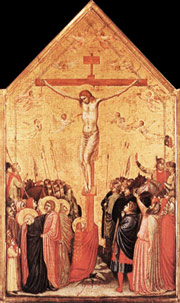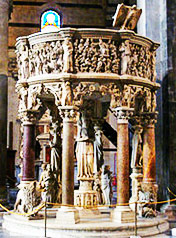Medieval Art
Medieval art covers the period from the end of the Roman Empire till the dawn of the Italian Renaissance in the 15th century. It includes a large variety of artistic styles, ranging from regional to international, each style being often divided into periods. There are also the particular national styles, interacting with the major Medieval art movements, still maintaining their unique character.
A short history of Middle Ages Art will follow, while the below links can be used for further reference.Medieval Gothic Art
Medieval Art of Illumination
Medieval Painting
The main periods of the Middle Ages Art
Early Christian ArtThe art of the early Middle Ages was somehow a debasement of the Roman. The difference consisted in the subjects represented, these being in accordance with the requirements of the early Christian communities. The form and method of the art remained classic for many centuries. After the fall of the Roman Empire, the Northern nations were influenced by the Roman civilization, and attempted to perpetuate it. Latin became the language of the Church and of higher culture. In architecture, the basilical system and the painting style of the frescoes of the Catacombs, were long present in the Medieval art.

Giotto di Bondone
Crucifixion, c.1330
Staatliche Museen, Berlin
Byzantine Art
Byzantine art covers more than a thousand years, until the fall of Constantinople in 1453. It is a conservative art, based on classical principles. An important Byzantine artistic achievement is the mosaic decoration art, brought to the highest level of monumentality and expressive power. The Byzantine art is also remarkable for its painting of devotional panels, resulting from the role played by the cult of icons in religious and secular life, and manuscript illumination. The architecture is showing the strong Roman legacy.
Celtic ArtCeltic artistic style developed in Southern Germany and Eastern France starting mid to late 5th century, and spread throughout Europe and the British Isles. It is characterized by sophisticated designs, with some classical influence. However, the stylized and fantastic plant and animal forms, and the geometrical patterns show a high degree of originality. Splendid examples of Celtic ornamentation art are the illuminated manuscripts like the Lindisfarne Gospels or the Book of Kells.
Medieval Pre-Romanesque Art (Carolingian)Charlemagne's time marked a new period in politics and arts development. From the art perspective, the period is also known as the Carolingian Renaissance. The capital of the new Empire, Aix-la-Chapelle, became a new Rome, while the Medieval Arts continued the antique traditions, with few independent innovations.
The new Medieval states were a result of combining the elements of the North with the civilization of Christian Rome. Political relations, which already appeared before the 8th century, culminated under the reign of Charlemagne, the founder of the Germanic empire, the great power of the time. The Medieval art models were those provided by the Italian Peninsula, mainly from Rome, Ravenna, and perhaps from Milan and its vicinity. The former Roman towns of the Rhine provinces also influenced the art. This is reflected by the palaces and churches of the Emperor, and in works of sculpture.
The components of Middle Ages art did not evolved all in the same manner. Painting and sculpture were not relieved instantly from their Byzantine subordination, and they were still restricted to the decoration of furniture, utensils, and manuscripts.
On the other hand, the Medieval architecture advanced rapidly. In some areas, the changes in art taking place within a single century were more important than thus observable since the time of Justinian.
Antique traditions started to fade in the time of Otto I, and by the middle of the 10th century, productions of the old art were given up in favor of more independent creations.
Medieval Romanesque ArtThe Medieval Romanesque, or Norman Art covers the period between the 10th and 12th century. From the horizontally ceiled basilicas of Otto’s reign to the vaulted Romanesque cathedrals of Mainz and Speyer, the advance is constant, and rational. In Germany, it resulted in a new style, with a clear plan, a constructive system, and a variety of artistic forms.
Around 1100, the principles of German Romanesque architecture were used in Western France, Northern Italy, and some areas of Eastern and Northern Europe. From here, the French and Italian art followed an independent course of development. The Provence and Tuscany based their style upon reminiscences of the antique, while in England the artistic methods were influenced by the French ones.
Medieval Gothic ArtMedieval art found its most brilliant expression, the Gothic style, in Northern France, towards the middle of the 12th century. At first, the Gothic Art was almost entirely limited to architecture, and was adopted in a short period of time by the neighboring countries. France became the centre of European culture, exercising a wide influence through the perfection of the Gothic. The new style was adopted by all the countries of Europe, except those still dependent upon the Byzantine Empire.
Local and International Medieval Art StylesThe evolution of Middle Ages art was marked by geographical differences. The first truly international style was the Romanesque. The Gothic was a combination of the French and local elements, resulting in local Gothic styles. Italy for example adopted only the constructive and decorative features which could harmonize with the existing architecture. Each of the Italian provinces retained its peculiar characteristics, the influence of the French style in the Papal States, for instance, being scarcely perceptible.
Medieval sculpture with its unique French works, was superior to that of the Roman epoch. It had a monumental character, and the portal sculptures of the 13th century were equaled only by the Italian marble works. In the free cities of Germany, the predominant burgher element elevated the conceptions and ideals of the middle class, and transformed the cycle of ecclesiastical representations. In Italy, the degree of independence from the French Art influence was even higher in sculpture and painting.

Giovanni Pisano
The Pulpit in Pisa Cathedral
The Medieval French art cultivated chiefly two branches of painting: illumination and stained glass painting. England also adopted them, while Germany followed with new methods in miniature painting, and perfection in the art of stained glass. However, the decorative tendencies of French miniatures, with brilliant colors influenced by stained glass paintings, were not adopted in Medieval German art. There were the pen drawings of Germany leading to the great woodcuts and copper engravings.
Medieval painters in Netherlands followed the development of miniature painting techniques in France. This resulted in the great works of panel painting of the early 15th century. The Medieval architecture of the Low Countries in the times of Jan van Eyck and Rogier was still purely Gothic.
In the first decades of the 15th century, the Italian Medieval art will take the place occupied by French art in the 12th century. From the arts perspective, Italy was more than fifty years in advance of the rest of Europe.
Great names of Medieval art, like Giotto and Giovanni Pisano, were followed by a generation of artists. Masolino and Fra Angelico were representative for the Middle Ages art, however their late Gothic works, especially Fra Angelico's, were already heralding the Renaissance.
